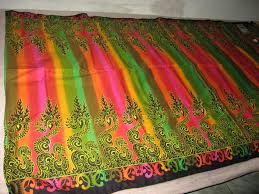The malong is a traditional "tube skirt" made of handwoven or machine-made multi-colored cotton cloth, bearing a variety of geometric or okir designs. The malong is akin to the sarong worn by peoples in Malaysia, Brunei andIndonesia. The malong is traditionally used as a garment by numerous tribes in the Southern Philippines and the Sulu Archipelago.

Handwoven malongs are made by Maranao, Maguindanao, and T'boli weavers on a backstrap loom. The pattern or style of the malong may indicate the weaver's tribal origin, such as the Maranao malong landap. Very rare malong designs and styles can indicate the village in which the malong was made, for example, the extremely intricate malong rawatan made only by a handful of Maranao weavers in Lanao del Sur, Mindanao. Handwoven malongs, which are costly, are likely to be used only at social functions, to display the social and economic status of the wearer. While modern malongs are made of cotton andLurex threads, some contemporary handwoven malongs are made of inexpensive rayon thread, to reduce the manufacturing cost to the weaver and ultimate cost to the consumer. There are many grades of cotton thread, and the cost of a malong can also be reduced by using the lesser grades of cotton thread, or by creating a loose or coarse weave.
Handwoven malongs are made by Maranao, Maguindanao, and T'boli weavers on a backstrap loom. The pattern or style of the malong may indicate the weaver's tribal origin, such as the Maranao malong landap. Very rare malong designs and styles can indicate the village in which the malong was made, for example, the extremely intricate malong rawatan made only by a handful of Maranao weavers in Lanao del Sur, Mindanao. Handwoven malongs, which are costly, are likely to be used only at social functions, to display the social and economic status of the wearer. While modern malongs are made of cotton andLurex threads, some contemporary handwoven malongs are made of inexpensive rayon thread, to reduce the manufacturing cost to the weaver and ultimate cost to the consumer. There are many grades of cotton thread, and the cost of a malong can also be reduced by using the lesser grades of cotton thread, or by creating a loose or coarse weave.
Machine-made printed cotton malongs are made in Indonesia specifically for export to the Philippines, and are commonly referred to as "batik" because the item is imported; those inexpensive machine-made malongs are used for everyday purposes. The designs of traditional handwoven designs are used in imported cotton from Thailand, allowing the purchaser to have a cotton machine-printed malong which, from a distance, convincingly mimics the look of a much more expensive handwoven malong.

The malong can function as a skirt for both men and women, a turban, a dress, a blanket, a sunshade, a bedsheet, a "dressing room", a hammock, a prayer mat, and other purposes. A newborn is wrapped in a malong, and as he grows this piece of cloth becomes a part of his daily life. When he dies, he is once again wrapped in a malong. Among traditional tribal peoples, the malong is used in everyday life. Even in areas where people wear Western-style clothing during the day, the malong is commonly used as sleepwear.The malong is also used in very big festivals, they wear this to show respect.
Reference: From the Rainbow's Varied Hue: Textiles of the Southern Philippines. Edited by Roy W. Hamilton. 1998. Fowler Museum of Cultural History, University of California at Los Angeles.


They only wore bahag (for men), some wore malong and putong over their head. They were also bare-footed

Royal Malong!!! This kind of malong is worn by Maranaw men and women of royal status.

They only wore bahag (for men), some wore malong and putong over their head. They were also bare-footed
Royal Malong!!! This kind of malong is worn by Maranaw men and women of royal status.


No comments:
Post a Comment